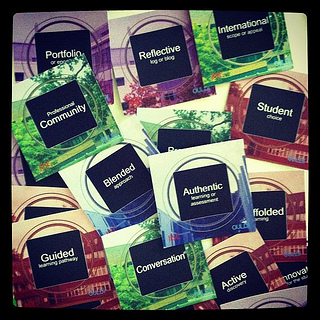Happy days: this week POTCert takes a look at educational technology and instructional design. I’m particularly interested in both of these fields because since starting on the Pedagogy First course, I’ve come to realise that both educational technology and instructional design are integral to the delivery of effective learning, and it seems that an online tutor would be well advised to understand something of each and to develop some of the respective foundation skills. I think that an understanding of the science and art of education, that is to say, pedagogy, combined with an understanding of educational technology and instructional design forms what I’d see as the “golden triangle” of online learning.
Already by week 2 of this course I’d developed a curiosity regarding instructional design, largely because I was unfamiliar with the term. Although Scott Johnson and Jim Julius explained the role of an instructional designer I was still unclear about the whole notion, probably due in a large part to the fact that I’d never actually met anyone who was an instructional designer. Even in January, when I went on to sign up for OLDSMOOC, an open online course in learning design, I still had no firm idea what it entailed, commenting:
I’ve no substantive idea of what learning design actually is; is it a fancy name for something that I do already when planning learning activities, is it something quite rigorous and scientific that I’ve hitherto not been exposed to, or is it something quite new altogether – a response to the way technology is impacting teaching and learning maybe.
Wikipedia offers the following explanation:
Instructional Design is the practice of creating “instructional experiences which make the acquisition of knowledge and skill more efficient, effective, and appealing.” The process consists broadly of determining the current state and needs of the learner, defining the end goal of instruction, and creating some “intervention” to assist in the transition. Ideally the process is informed by pedagogically (process of teaching) and andragogically (adult learning) tested theories of learning
and, as more and more open and participatory learning opportunities became available, increasingly heutagogically tested ones as well, I’d venture.
Any way, looking back at my initial musings, it turns out that instructional design comprises all three of my premises.
By the way, I prefer to use the term learning design; I might explain that instructional design is the term more commonly used in the US whereas in the UK and Europe, it’s learning design.
In her book, Designing for Learning in an Open World, Grainne Conole explains learning design as “a methodology for enabling teachers/designers to make more informed decisions in how they go about designing learning activities and interventions, which are pedagogically informed and make effective use of resources and technologies”. It seems that in the field of education many are coming to see educational practice as the design inquiry of learning, after all “design science is concerned with how things should be” (Simon, 1969 quoted by Mor, 2013).
From my OLDSMOOC experience, I can now appreciate that learning design science provides both a rigorous method and a variety of tools to help ensure the development, and continuous improvement, of learning experiences. Here is a brief overview of the design process:
- Initiate – proposal of a learning need
- Inquire – inquire into the learning context
- Ideate – sketch out a course design
- Connect – develop learning activities
- Prototype – test out aspects of the design
- Evaluate – evaluate as part of the iterative process of learning design
- Reflect – reflect and share learning or design narratives
If you want to leran more about the process of learning design I strongly suggest that you take a look at the comprehensive range of resources on the OLDSMOOC website.
In her explanation above, Grainne Conole points out that learning design “makes effective use of resources and technologies”. Wikipedia says that educational technology “is the study and ethical practice of facilitating e-learning, which is the learning and improving of performance by creating, using and managing appropriate technological processes and resources”, and furthermore, that the term “is often associated with, and encompasses, instructional theory and learning theory”. So, it seems that the three fields of pedagogy, learning design and educational technology are indeed bound inextricably closely together.
Although, the POTCert course has given me great insight into the use of technology, I’m aware that my knowledge in this respect is still quite superficial. So, like I mentioned in a previous post, seeing as I’ve a notion of “cobbling together an LMS“ of my own from a variety of web technologies, I’m keen to develop my knowledge and skills further in relation to educational technology. For that reason, I’m hoping to participate in the upcoming Open Course in Technology Enhanced Learning offered by the Association for Learning Technologies in the UK. It’s all good fun.
Image source: catspyjamasnz http://www.flickr.com/photos/catspyjamasnz/8181463539/in/photostream/
References:
Mor, Y. (2013) Learning Design for a 21st Century Curriculum- A Massive Open Online Course. Available at: http://prezi.com/b44jwdgvs8nl/olds-mooc-introduction/
Conole, G. (2013) Designing for Learning in an Open World. Springer. New York

This work is licensed under a Creative Commons Attribution-NonCommercial-ShareAlike 3.0 Unported License.
